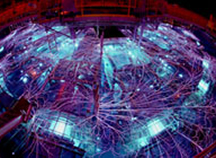Ions produced by Sandia’s Z machine have exceeded 2 billion degrees Kelvin, 10 times hotter than any fusion experiment on Earth and hotter than the interiors of stars.

The reaction, if it could be harnessed, presents the possibility of eventually building smaller, hotter nuclear fusion plants to produce the same amount of energy as larger, cooler plants.
A description of the achievement and its theoretical explanation — which appeared in the Feb. 24 Physical Review Letters — also could serve to describe how astrophysical entities like solar flares maintain extreme temperatures.
The temperatures, first recorded approximately 18 months ago, puzzled Sandia researchers because they were roughly four times stronger than the estimated kinetic energy of the machine’s implosion phase, where a magnetic field smashes ions together to release heat in the form of X-rays.
According to the conventional view of Z-pinches, the emitted heat should be less — not more — than the kinetic energy from which it came.
“Dave LePell [1646] measured the temperature,” says team leader Chris Deeney (1640), “which prompted the question: how can it be that high for so long?”
“Long,” in this case, was 10 nanoseconds.
Because the team was concerned about possible errors in measurement, they did not report the readings at first but instead — coordinating with computer models created by John Apruzese at the Naval Research Laboratory — did additional experiments.
Measurements were possible even at these extreme temperatures because emerging X-rays create spectral lines on a spectrometer. The width of the line establishes its temperature.
“Depending on how hot they are,” Chris says, “the rays move with a given velocity that produces a [Doppler] red or blue shift that widens the spectral line.” But, he says, “Other phenomena could cause the line to broaden: for example, plasma opacity that would cause emitted X-rays to be reabsorbed, depressing the center.”
When no error was found, Chris and Dave, along with Christine Coverdale (1344) and Brent Jones (1646), who helped plan and lead the shots, turned to Sandia consultant Malcolm Haines, well-known for his work in Z pinches as a physics professor at the Imperial College in London.
Haines theorized that the rapid conversion of magnetic energy to a very high ion plasma temperature was achieved by magnetohydrodynamic instabilities at stagnation, when the ions and electrons could travel no further. At this point, all the kinetic energy should have been used up and the plasma collapsed. But some unknown energy was still pushing back against the magnetic field.
The surprising explanation theorizes that Z’s magnetic energies create microturbulences that increase the kinetic energies of ions caught in the field’s grip. The extra jolt of kinetic energy then produces increased heat, as ions and their accompanying electrons release energy even after they should have been exhausted.
High temperatures previously had been assumed to be produced entirely by the kinetic flight and intersection of ions and electrons, unaided by accompanying microturbulent fields.
In these experiments, the work was done by magnetically imploding ions from stainless steel wires 55 to 80 mm in diameter.
The Z machine’s magnetic field is created by an electrical current of 20 million amperes. The current burns out the wires like a short circuit in an automobile burns out a fuse.
The temperatures are produced in unadorned, flat-roofed Bldg. 983 — about the size and shape of an aging high-school gymnasium — in Sandia Technical Area 4.
This work has already prompted other studies at Sandia and the University of Nevada, Reno.